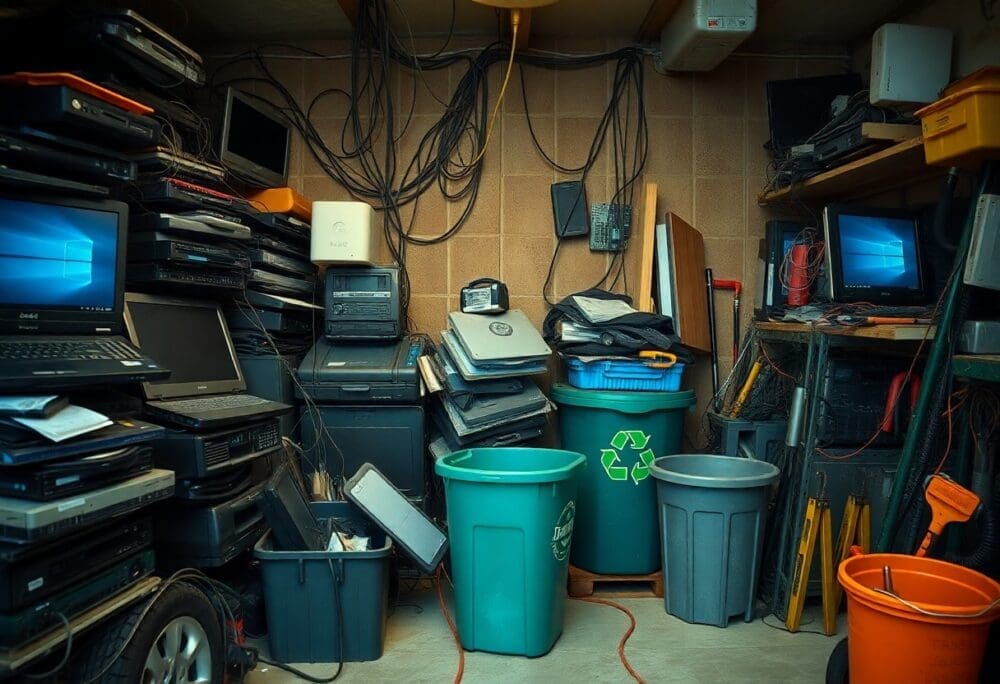You need to be mindful about how you handle broken electronics when it comes to junk removal. These devices often contain materials that can harm the environment if not disposed of properly. With a few simple steps, you can ensure that your broken electronics are recycled or disposed of in an eco-friendly manner. In this post, we will guide you through the necessary practices for effectively managing your old gadgets while prioritizing your responsibility to the planet.
Key Takeaways:
- Assess the condition of the broken electronics to determine if they can be repaired or reused before considering disposal.
- Research local recycling programs or facilities that accept electronic waste to ensure responsible disposal and help minimize environmental impact.
- Remove any personal data from devices, such as hard drives and phones, to protect your privacy before junk removal.
Understanding E-Waste
A growing concern in our tech-driven society is electronic waste, commonly known as e-waste. This category includes obsolete, broken, or discarded electronics that pose significant disposal challenges. Proper awareness and disposal methods are vital to mitigate both environmental and health issues caused by improper handling.
Definition and Types of Electronic Waste
As you encounter broken gadgets, it is important to know that e-waste encompasses a variety of devices, including:
- Old computers and laptops
- Smartphones and tablets
- Televisions and monitors
- Home appliances like microwaves and toasters
- Networking equipment such as routers
Perceiving the broad spectrum of e-waste will help guide your disposal choices, ensuring you make informed decisions.
| Type of E-Waste | Examples |
| Computing Devices | Laptops, desktops |
| Mobile Devices | Smartphones, tablets |
| Display Devices | Televisions, monitors |
| Home Appliances | Microwaves, refrigerators |
The Environmental Impact of E-Waste
EWaste significantly impacts the environment due to the hazardous materials it often contains, including lead, mercury, and cadmium. These substances can leach into the soil and waterways, posing risks to wildlife and human health.
Consequently, the improper disposal of e-waste contributes to pollution and resource depletion. Recycling electronics ensures valuable materials are reclaimed, resulting in less mining for raw materials. By responsible disposal, you help protect the environment and promote sustainable practices in tech consumption.
Assessing Your Broken Electronics
One of the first steps in managing broken electronics during junk removal is to assess their condition. Take the time to inspect each item for visible damage, signs of wear, or malfunction. Identify whether the issue is minor, requiring a simple fix, or whether the device is beyond repair. Understanding the state of your broken electronics will guide you in making informed decisions about disposal, repair, or recycling options.
Repairability vs. Replacement
One key factor to consider is the repairability of your electronics compared to the cost and feasibility of replacement. Evaluate whether you can fix the item yourself or if professional help is necessary. Sometimes, repairing can be a more cost-effective solution, especially for high-value electronics. However, in many cases, it may be more efficient to replace the broken device altogether.
Determining Value and Usability
The next step is to determine the value and usability of your broken electronics. Assess whether the device can be salvaged for parts, used for repairs, or recycled. Some items may still retain a resale value, even in their broken state, while others might be completely non-functional.
Determining the value and usability of your electronic devices can not only influence your next steps but also help make sustainable choices. Research similar items online to get an idea of their market value and potential resale opportunities. Additionally, consider whether certain components or materials can be repurposed, allowing you to reduce waste and contribute to environmental efforts. By evaluating these factors, you can make informed decisions that align with both your budget and eco-friendly practices.
Responsible Disposal Options
Once again, when dealing with broken electronics, it’s vital to consider responsible disposal options. You might wonder Are junk removal services able to get rid of electronic items effectively? You have several avenues to explore that prioritize the environment and your community well-being.
Recycling Programs
Responsible recycling programs can help you dispose of your broken electronics safely. Many local recycling centers accept electronic devices and process them in a manner that prevents harmful materials from ending up in landfills. Check your area’s guidelines to find a facility that can handle your e-waste properly.
Donation and Resale Opportunities
Beside recycling, you may have the chance to donate or sell your broken electronics. Organizations or individuals may find value in parts or repair opportunities, extending the life cycle of your devices.
Options for donation and resale can include local charities, schools, or online marketplaces where someone may want to repair and reuse your electronics. Before donating, ensure that your device is safely wiped of personal data. This way, you assist others while giving your old electronics a chance at a second life.
Junk Removal Services
Unlike traditional waste management, junk removal services specialize in handling items like broken electronics that may require special consideration. These services provide a convenient and efficient way to dispose of your unwanted electronics, ensuring they are either recycled properly or disposed of in an environmentally friendly manner. By opting for professional junk removal, you can save time and avoid any potential hazards associated with handling broken electronics yourself.
Choosing the Right Service
The key to successful junk removal lies in selecting a service that aligns with your needs. Look for companies that have experience in handling electronic waste, adhere to recycling regulations, and can provide transparent pricing. Reading reviews and checking for certifications can help you make an informed choice, ensuring your broken electronics are treated responsibly.
What to Expect During Junk Removal
Beside quick removal, junk removal services typically include an assessment of the items you want to dispose of, providing you with a clear estimate before proceeding. The team will handle all the heavy lifting, loading, and transportation, making the process easy and hassle-free for you.
Another aspect to consider is the thoroughness of the service. When the junk removal team arrives, they will evaluate your electronics and discuss any specific disposal needs. You can expect them to provide advice on recycling options and even offer insights into the environmental impact of your discarded items. This ensures that you not only clear out your space but also contribute positively to sustainability efforts.
Proper Data Disposal
Not all broken electronics should end up in a landfill, especially when they contain sensitive data. Proper data disposal is imperative to protect your personal information from falling into the wrong hands. It’s not just about getting rid of your old devices; it’s about ensuring that your private information stays private and secure. Implementing the right steps for data disposal is an important part of the junk removal process.
Importance of Data Security
Disposal of electronic devices without secure data management can expose you to identity theft and fraud. Cybercriminals often seek discarded electronics to retrieve personal information that can lead to unauthorized transactions. Prioritizing data security is imperative for safeguarding your identity and financial information, even when parting ways with old devices.
Methods for Secure Data Erasure
Importance of choosing the right methods for secure data erasure cannot be overstated. Several techniques can effectively eliminate sensitive information from your devices. Options include using software that overwrites data, performing a factory reset, or physically destroying the storage medium. Each method ensures that your personal data is irretrievable by anyone who might come across your discarded electronics.
Also, consider whether you want to pursue a DIY approach or hire professionals for data erasure. While there are user-friendly software options available, professional services can provide advanced methods like degaussing or hard drive shredding, offering an extra layer of protection. Evaluating your needs and the sensitivity of your data will help you make the right decision for secure data erasure.
Preparing for Junk Removal
For a successful junk removal process, it’s necessary to prepare your broken electronics beforehand. Start by gathering all your broken devices in one location. This will not only simplify the removal process but also help you determine what can be salvaged, recycled, or disposed of properly.
Steps to Take Before Removal
Removal should begin with ensuring that you have unplugged and disconnected any devices from power sources. Safely remove batteries from electronic devices where applicable, and check for any personal information stored on hard drives or devices to wipe them clean.
Organizing and Sorting Electronics
Preparing to organize and sort your electronics can streamline junk removal significantly. Group similar items together, such as computers, TVs, or small appliances, to ease the whole process.
But take the time to differentiate between items that can be recycled and those that need to be disposed of. Many electronics can still hold valuable materials and should be placed in appropriate recycling bins. Be sure to check local regulations for e-waste disposal, as this will guide you in sorting your electronics correctly and responsibly.
Conclusion
Conclusively, when dealing with broken electronics during junk removal, you should prioritize responsible disposal options. Consider recycling programs or donation centers that accept non-functional devices, ensuring they are processed safely and sustainably. Additionally, check local regulations regarding e-waste disposal to avoid fines and promote environmental responsibility. Taking these steps not only helps you declutter but also contributes to a healthier planet.
Q: What should I do with broken electronics before junk removal?
A: Before junk removal, you should assess the condition of your broken electronics. If the items are beyond repair but are still functioning in some capacity, consider recycling them properly at a local e-waste recycling facility. Many communities have programs to ensure that electronic items are disposed of safely and sustainably, which helps prevent harmful materials from entering landfills. If you’re not sure where to find these facilities, research online or contact your local waste management department for guidance.
Q: Can I throw away broken electronics in regular trash during junk removal?
A: It is not advisable to throw broken electronics in regular trash due to the harmful substances they may contain, such as lead, mercury, and cadmium. These materials can pose serious environmental and health risks when they break down in landfills. Instead, utilize specialized junk removal services that offer electronic disposal and recycling options to ensure that your electronics are handled responsibly and in accordance with local regulations.
Q: What type of broken electronics can be recycled during junk removal?
A: Various types of broken electronics can be recycled during junk removal, including but not limited to old televisions, computers, laptops, printers, smartphones, tablets, and gaming consoles. Some recycling facilities also accept smaller gadgets like chargers, cables, and audio devices. Always check with your chosen recycling center to confirm which items they accept, and if possible, remove any personal data from devices like computers or phones before disposing of them to protect your privacy.





